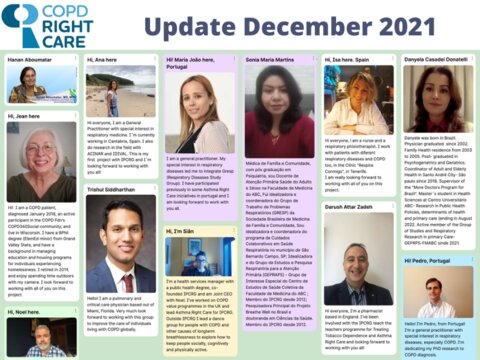COPD Right Care - Update December 2021

Key to the success of the Asthma Right Care project was the creation and development of tools that would enable behaviour-changing conversations between health professionals and between health professionals and patients. The main tool arising from the thinking and discussions of our multi-country and multi-professional delivery team resulted in development and then country adaptations of the tool we called the SABA Slide Rule.
As we tested this tool for asthma we realised that it had the effect of increasing the interest of patients, parents and health professionals in finding out how better to move from episodic and crisis care with SABA to a long-term approach of controlled and prevented asthma symptoms and attacks.
We have been working over the last few months designing the COPD Right Care tools with our patient and health professional experts from Brazil, Portugal, Spain, UK and the USA and have reached agreement about what conversation triggers we think our first followers should be exploring with their colleagues, patients and carers.
What is apparent for COPD vs Asthma is that the level of interest in doing the right thing is already high, but, it can be hard to know what to do, the breadth of options that are available, how to select treatment plans and goals at different times and manage the complexity when multi-morbidity exists.
The COPD Right Care Wheel - Key Principles
Therapeutic Choices - Making the right thing to do, the easy thing to do.
The tool will tell a positive and hopeful story about the range of high value therapies available, from vaccines, through tobacco dependence treatment, exercise and rehabilitation, nutritional support, medicines and surgery. Using the GOLD guidance and principles and thinking about the different but sometimes overlapping phenotypes of COPD we will simplify the message about therapeutic choices that can be made for each phenotype for primary care prescribers. We will highlight that medicine efficacy is important but also safety and patient preference.
Supporting patient understanding and decision making
Clinical and cost-effective COPD care requires not only a correct diagnosis and dynamic care plan, but also a well communicated one that is created with consensus. Knowing how to select and apply a range of interventions is an important start but checking the understanding of the person being diagnosed and living with COPD, their personal circumstances, goals and choices, should have equal status.
For this tool we will use two established approaches to working with people with long-term conditions.
Leventhal’s Self-Regulatory Model
- Identity - What is it called?
- Timeline - What will happen in the future?
- Cause - Why do I have it?
- Control/Cure - What can be done?
- Consequences - What will be the effect of my choices?
The OARS tool for motivational interviewing
- Open questioning
- Affirming
- Reflecting
- Summarising
The IPCRG Inhaled Corticosteroid Safety Card for people with COPD
We now recognise that in our pilot countries and in others, there is no systematic alert or warning system for people who are taking regular therapeutic corticosteroids. There is of course good individual practice in these countries, principally for people on oral or injectable replacement steroids for insufficiency syndromes with sick day rules and rescue plans. But it is not systematised and is usually not seen in relation to prescription of inhaled corticosteroids, where high daily doses are often prescribed for people with the phenotype who benefit from steroid therapy in COPD.
Recognising the underlying difference in prescribing options, pharmacy support and involvement, pre-existing medicines safety systems, each of the pilot countries will design their own card adapting from the common source developed in the UK. We look forward to seeing the result of the testing process that our design team follow in their countries in 2022.